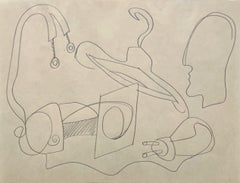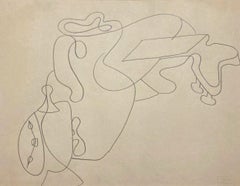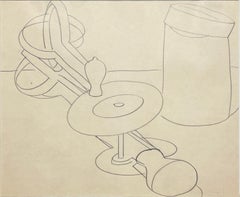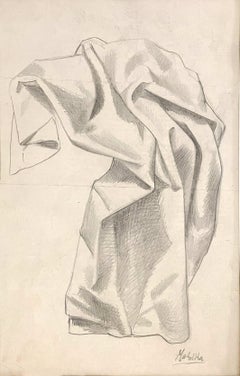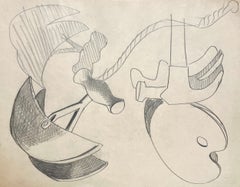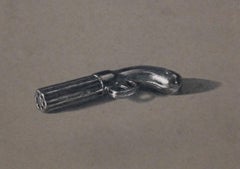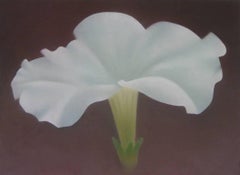Jan Matulka Still-life Drawings and Watercolors
American, 1890-1972
Matulka studied at the National Academy of Design before traveling to the American Southwest, where he grew inspired by Native-American and Hispanic cultures. Matulka used this inspiration upon returning home to create representational yet distorted artworks. Matulka fluidly oscillates between abstraction and figural painting. He has had many solo exhibitions across NYC and has had his work displayed in notable locations such as The Brooklyn Museum, the Museum of Modern Art, the Whitney Museum of American Art, the Guggenheim Museum, and the Smithsonian American Art Museum.to
1
4
1
Overall Width
to
Overall Height
to
5
5
5
5
5
3
1
1
1
1
1
5
5
5
10
85
69
42
30
5
Artist: Jan Matulka
1930s Surrealist Still Life with Profile and Hanger by Artist Jan Matulka
By Jan Matulka
Located in Chicago, IL
A 1930 graphite on pencil drawing of Surrealist still life of an egg beater by notable artist Jan Matulka. Image size: 8 1/2" x 11". Archivally matted to...
Category
1930s Modern Jan Matulka Still-life Drawings and Watercolors
Materials
Paper, Graphite
1930s Surrealist Still Life with Alarm Clock and Mandolin by Artist Jan Matulka
By Jan Matulka
Located in Chicago, IL
A ca. 1930s graphite on pencil drawing of Surrealist still life of an egg beater by notable artist artist Jan Matulka. Artwork size: 8 1/2" x 11". Archiv...
Category
1930s Modern Jan Matulka Still-life Drawings and Watercolors
Materials
Paper, Graphite
1930s Surrealist Composition of Still Life with Egg Beater by Artist Jan Matulka
By Jan Matulka
Located in Chicago, IL
A 1930s graphite on pencil drawing of Surrealist still life of an egg beater by notable artist Jan Matulka. Artwork size: 8 1/2" x 11". Archivally matted...
Category
1930s Modern Jan Matulka Still-life Drawings and Watercolors
Materials
Paper, Graphite
A ca. 1938 Graphite on Paper Study of Classical Drapery by Modernist Jan Matulka
By Jan Matulka
Located in Chicago, IL
A ca. 1938 graphite on paper, study of a classical drapery by notable Modernist artist Jan Matulka. The image is drawn on the back of a typewritten, folded sheet of stationery, from...
Category
1930s American Modern Jan Matulka Still-life Drawings and Watercolors
Materials
Paper, Graphite
1930s Surrealist Still Life with Hammer, Palette and Chopper by Jan Matulka
By Jan Matulka
Located in Chicago, IL
A 1930s graphite on pencil drawing of Surrealist still life of an egg beater by notable artist Jan Matulka. Artwork size: 8 1/2". x 11". Matted size: 14...
Category
1930s Modern Jan Matulka Still-life Drawings and Watercolors
Materials
Paper, Graphite
Related Items
Gun from Clue
By A.J. Fries
Located in Buffalo, NY
An original mixed media drawing by American artist A.J. Fries.
Category
21st Century and Contemporary Realist Jan Matulka Still-life Drawings and Watercolors
Materials
Gouache, Graphite, Paper
Flower
By Robert Peterson
Located in Dallas, TX
Robert Peterson, "Flower," pastel on paper, 19 x 26 1/4 inches paper size, 27 1/4 x 35 inches including white mat and frame.
The artwork is floated in the mat and only hinged at the...
Category
20th Century American Modern Jan Matulka Still-life Drawings and Watercolors
Materials
Paper, Pastel
Antique American Floral Still Life of Roses, Delicately Rendered
Located in Grand Rapids, MI
Antique Floral Still Life of Roses, Delicatly Rendered
American, 19th/20th Century
Signed: A. Ziffel 1906 (Lower, Right)
" Still Life of Roses ", 1906
Watercolor and Gouache on...
Category
Early 20th Century Jan Matulka Still-life Drawings and Watercolors
Materials
Paper, Watercolor, Gouache, Graphite
Untitled, Still Life of Shell
Located in Fairlawn, OH
Untitled, Still Life of Shell
Graphite on paper, 1945-1951
Signed lower right in pencil "Bisttram" (see photo)
Condition: Excellent
Sheet size: 9.63 x 7 .5 inches
EMIL BISTTRAM (189...
Category
1940s American Modern Jan Matulka Still-life Drawings and Watercolors
Materials
Graphite
"500 Calories al mode" The Perfect Meal - Menu - Dessert - Collograph Watercolor
Located in Soquel, CA
"500 Calories al mode" The Perfect Meal - Menu - Dessert - Collograph Watercolor
The artwork "500 Calories al mode" by Betty Swift, created one of a group show at San Francisco Stat...
Category
1980s American Modern Jan Matulka Still-life Drawings and Watercolors
Materials
Watercolor, Laid Paper, Etching
$600 Sale Price
20% Off
H 14 in W 11 in D 0.5 in
'Still Life', Louvre, California Post-Impressionist, LACMA, Académie Chaumière
By Victor Di Gesu
Located in Santa Cruz, CA
Estate stamp, verso, for Victor di Gesu (American, 1914-1988) and painted circa 1955.
Winner of the Prix Othon Friesz, Victor di Gesu first attended the Los Angeles Art Center and t...
Category
1950s Jan Matulka Still-life Drawings and Watercolors
Materials
Watercolor, Laid Paper, Graphite
$3,600
H 15 in W 20 in D 0.05 in
Study of horse and ox bones
By Salvator Rosa
Located in Middletown, NY
Graphite, ink wash and watercolor on handmade laid paper with a large, indistinguishable ovoid watermark with a bunch of grapes, 8 7/16 x 12 5/8 inches (225 x 320 mm), signed in brown ink in the lower left. With the Henry Scipio Reitlinger oval stamp in brown ink on the verso (Lugt 2274a).
The condition of the image and paper is consistent with age, there is minor toning on the recto and some attenuation of the green pigment. The drawing is laid down to an 18th century laid paper support and has a small pencil notation in the lower right corner (modern), and scattered notations in pencil on the verso of the support (also modern, perhaps auction/accession notes). On the paper support is an ink drawing in red and black of what appears to be the floor plan for the wing of a large building. The drawing is top-up, adhered facing the verso of the drawing. The architectural drawing on the support is visible through to the recto of the composition when the sheets are viewed through raking light. There is a small area of stipple point spotting in brown ink on the verso of the support. Examination under black light shows no indication of repairs or additions, expert or otherwise.
Provenance:
Henry Scipio Reitlinger was born in either 1882 or 1885, attended Kings College...
Category
Mid-17th Century Old Masters Jan Matulka Still-life Drawings and Watercolors
Materials
Ink, Handmade Paper, Laid Paper, Graphite
Sea Shells – Blue & Gold
By Zama Vanessa Helder
Located in Los Angeles, CA
Sea Shells – Blue & Gold, c. 1940s, watercolor on paper, signed upper left, 15 x 19 ¼ inches (image); title and artist’s name and address inscribed verso, presented in a newer glazed...
Category
1940s American Modern Jan Matulka Still-life Drawings and Watercolors
Materials
Paper, Watercolor
Three Flowers
By Joseph Stella
Located in New York, NY
Joseph Stella was a visionary artist who painted what he saw, an idiosyncratic and individual experience of his time and place. Stella arrived in New York in 1896, part of a wave of ...
Category
20th Century American Modern Jan Matulka Still-life Drawings and Watercolors
Materials
Paper, Crayon
Still Life
By Earl Horter
Located in Bryn Mawr, PA
Best known as an impassioned supporter and avid collector of modern art, Earl Horter was also an artist himself. Largely self-taught, Horter was a highly skilled draftsman and engrav...
Category
1930s American Modern Jan Matulka Still-life Drawings and Watercolors
Materials
Paper, Pastel
Summer Set 8, watercolor monoprint (unique) on Dieu Donne handmade paper, signed
By Arlene Shechet
Located in New York, NY
Arlene Shechet
Summer Set 8, 2005
Watercolor monoprint on dieu donné hand made paper
21 × 27 1/2 inches
Signed and dated in graphite on the front
Exquisite watercolor monoprint on di...
Category
Early 2000s Contemporary Jan Matulka Still-life Drawings and Watercolors
Materials
Watercolor, Handmade Paper, Monoprint, Mixed Media, Graphite
White Poppies - Botanical Watercolor on Paper
Located in Soquel, CA
White Poppies - Botanical Watercolor on Paper
Detailed floral watercolor by Harry Federico (American, 1922-2022). Several white poppies ...
Category
21st Century and Contemporary American Modern Jan Matulka Still-life Drawings and Watercolors
Materials
Watercolor, Laid Paper
$1,150
H 21.25 in W 27.25 in D 1 in
Jan Matulka still-life drawings and watercolors for sale on 1stDibs.
Find a wide variety of authentic Jan Matulka still-life drawings and watercolors available for sale on 1stDibs. You can also browse by medium to find art by Jan Matulka in graphite, paper, pencil and more. Much of the original work by this artist or collective was created during the 1930s and is mostly associated with the modern style. Not every interior allows for large Jan Matulka still-life drawings and watercolors, so small editions measuring 1 inch across are available. Customers who are interested in this artist might also find the work of Ian Hornak, Sylvia Spicuzza, and Nancy Lasar. Jan Matulka still-life drawings and watercolors prices can differ depending upon medium, time period and other attributes. On 1stDibs, the price for these items starts at $850 and tops out at $850, while the average work can sell for $850.
